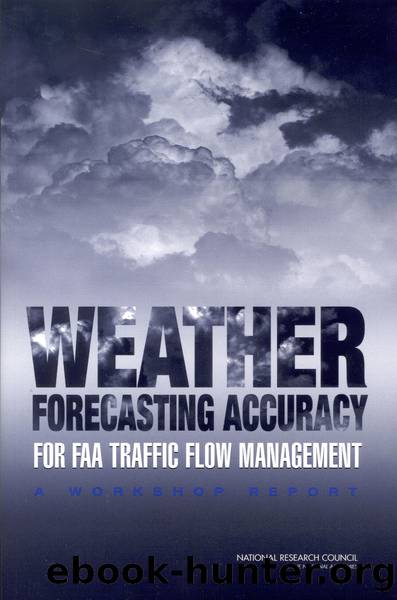WEATHER FORECASTING ACCURACY FOR FAA TRAFFIC FLOW MANAGEMENT: A WORKSHOP REPORT by National Research Council of the National Academies

Author:National Research Council of the National Academies
Language: eng
Format: epub
Tags: Earth Sciences : Climate, Weather and Meteorology
Publisher: NATIONAL ACADEMY PRESS
Published: 2003-02-28T00:00:00+00:00
Given that the research needed to meet the above challenges is broad and significant, Dr. Droegemeier proposed that the most important concerns might be additional developments in three- and four-dimensional data assimilation, including the especially promising ensemble Kalman filter. Indeed, the creation of suitable initial conditions for forecast models is the key element to successful storm-scale NWP. New observing systems, such as the planned phased array radar, along with current GPS water vapor sensing technologies, show great promise in this regard. Especially important is remote sensing of the lowest 3 km of the atmosphere, which has received relatively little attention and where many key processes governing convective initiation occur.
Also important are improvements to forecast models, especially their representation of surface and subsurface features and processes, and the coupling of the ground surface to the atmosphere. Cloud physics modeling schemes today are quite sophisticated, but little routinely available observational information exists with which they can be initialized. Dual-polarization Doppler radar holds promise in this area. Dr. Droegemeier proposed that the impact on forecast quality of various types of data, and a determination of the optimal mix of observations, should be assessed, and techniques should be developed for storm-scale ensemble forecasting. Further, accurate estimation of observational and model error statistics, both of which are extremely important for modern data assimilation techniques, is essential, and statistical techniques for forecast verification at the storm scale should be developed since conventional methods are not applicable. Indeed, Dr. Droegemeier indicated that these latter techniques should go beyond traditional skill measures and include elements of value and risk.
It is perhaps not inappropriate to end by asking whether, after all this work, reliable storm-scale NWP is even theoretically possible. In contrast to the large-scale atmosphere, where pioneering work by Lorenz (1969) continues to define the theoretical limits of predictability, no similar body of work has been undertaken at the storm scale. Interestingly, the practical demonstration of global numerical prediction preceded Lorenzâs theory by roughly a decade, and the same appears to be happening at the storm scale. Relatively clear, however, is that Lorenzâs analysis does not appear to be valid for the storm scale, principally because it is not suitable for highly intermittent flows, and because its formulation is inconsistent with the limited-area domains being applied to the small-scale atmosphere.
Alexander MacDonald, of the National Oceanic and Atmospheric Administrationâs Forecast Systems Laboratory, concluded the session with a call for sustaining and improving the nationâs meteorological observation capabilities. He indicated that, if the observational network is maintained and improved, significant improvements in convective forecasts are possible (though not to the levels requested by the FAA) in the next 2 to 5 years. Current understanding of model physics is sufficient to provide increasingly accurate convective forecasts if observations of high spatial and temporal resolution are available to be blended with models. In particular, better observations of moisture could allow for significant improvements in model representations of convection. At a minimum, models need to run every hour to provide more accurate information of value to aviation users.
Download
This site does not store any files on its server. We only index and link to content provided by other sites. Please contact the content providers to delete copyright contents if any and email us, we'll remove relevant links or contents immediately.
Whiskies Galore by Ian Buxton(41880)
Introduction to Aircraft Design (Cambridge Aerospace Series) by John P. Fielding(33064)
Rewire Your Anxious Brain by Catherine M. Pittman(18553)
Craft Beer for the Homebrewer by Michael Agnew(18141)
Cat's cradle by Kurt Vonnegut(15186)
Sapiens: A Brief History of Humankind by Yuval Noah Harari(14252)
Leonardo da Vinci by Walter Isaacson(13184)
The Tidewater Tales by John Barth(12608)
Thinking, Fast and Slow by Kahneman Daniel(12079)
Underground: A Human History of the Worlds Beneath Our Feet by Will Hunt(12024)
The Radium Girls by Kate Moore(11921)
The Art of Thinking Clearly by Rolf Dobelli(10224)
A Journey Through Charms and Defence Against the Dark Arts (Harry Potter: A Journey Throughâ¦) by Pottermore Publishing(9232)
Mindhunter: Inside the FBI's Elite Serial Crime Unit by John E. Douglas & Mark Olshaker(9203)
Tools of Titans by Timothy Ferriss(8218)
Wonder by R. J. Palacio(8010)
Turbulence by E. J. Noyes(7936)
Change Your Questions, Change Your Life by Marilee Adams(7635)
Nudge - Improving Decisions about Health, Wealth, and Happiness by Thaler Sunstein(7615)
